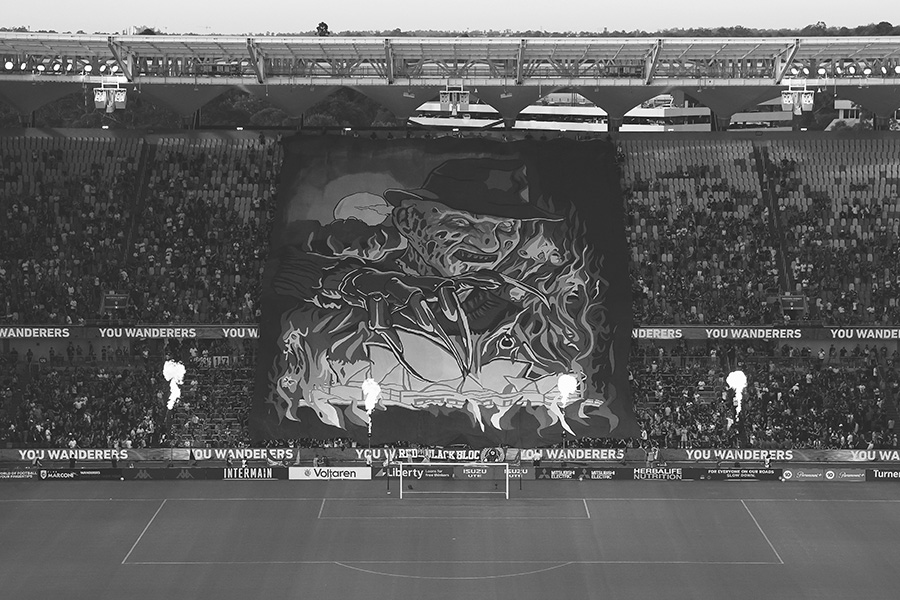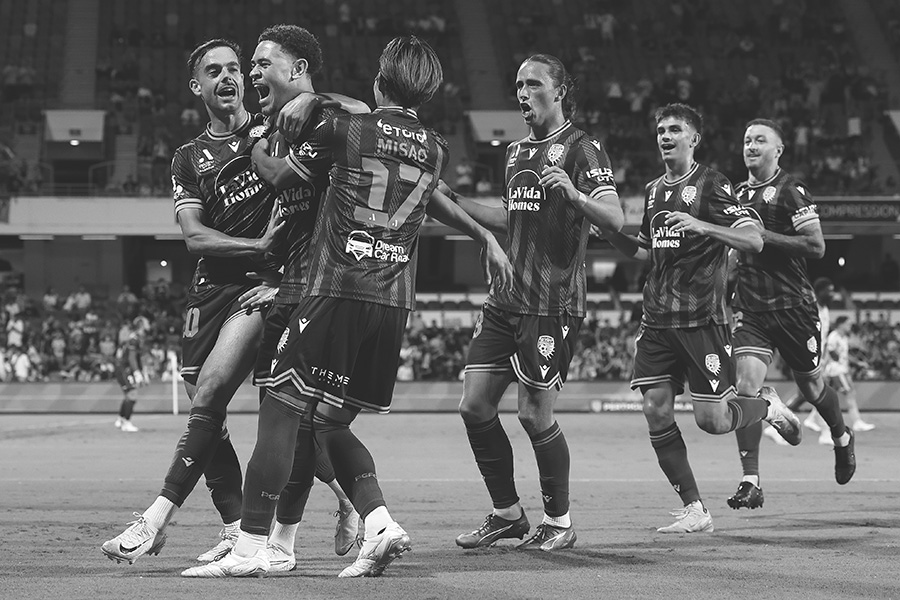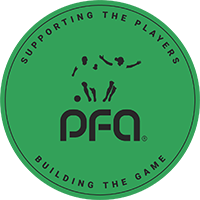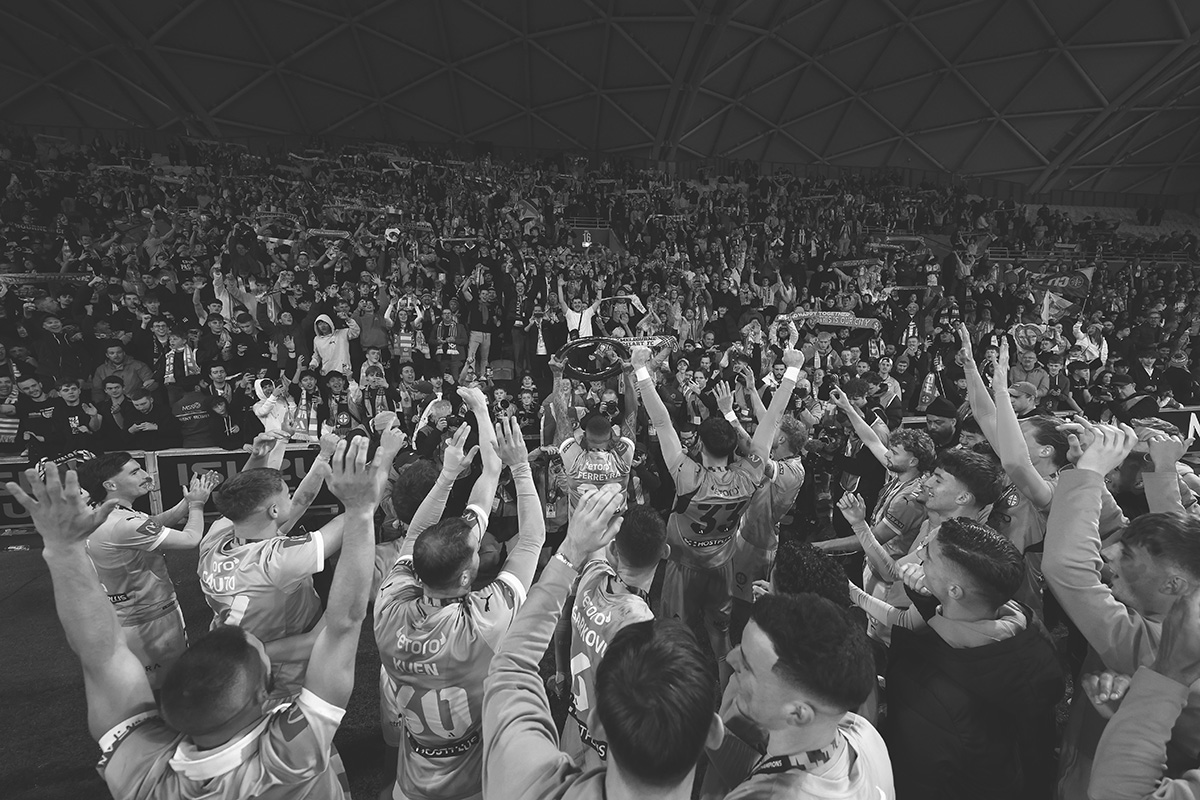Introduction
In 2024, the PFA embarked on a round of extensive research to understand the trajectories of the A-Leagues, the size of the opportunities, and areas for reform. Obviously, a key area of focus was the leagues’ relationships with fans. The PFA engaged leading sports intelligence agency Gemba to conduct market sizing and a mass fan survey. Separately, the PFA conducted its own ‘mini’ fan focus groups with fans (current, potential, or lapsed) of the two leagues. This report summarises the findings of the A-League Men (ALM) focus groups.
The ALM focus groups were held in June, 2024. The PFA targeted participants who were once passionate ALM fans, whose support had waned to some degree over the years. The logic of this targeted approach is that the ALM’s support – in the form of attendances, viewership, and Gemba’s underlying metrics – was significantly higher a decade ago than today. Simply returning to those levels represents a significant upside opportunity for the ALM and it is theoretically easier to reengage lapsed fans than to attract brand new ones. As a result, the insights are most relevant to understand what has changed in the past decade and what factors might convert the ‘lowest hanging fruit’. This study is not as relevant for understanding how to get the general population interested in football in the first place, for example.
The PFA reached out through staff contacts and fan networks to recruit participants. Seven ALM fans participated across two ‘mini’ focus groups. There were fans of Sydney FC (x2), Central Coast Mariners, Melbourne Victory, Melbourne City, Adelaide United, and Perth Glory. The participants were all men, not by design but because they were the only suitable candidates available to attend. There was a broad range of ages.
The fans were asked to describe factors that contributed to their initial conversion into ALM die-hards and then to their decline in engagement. The conversations were analysed to identify consistent themes or aspects discussed by multiple participants. Seventeen resulting insights have been organised into six categories, as shown in the table below. Throughout this report, each insight is supported by a paraphrased summary of the relevant fan comments, a selection of the actual quotes, or a combination of the two.
The PFA will synthesise the most pertinent findings into a broader document recommending reforms for the ALM across a range of areas. This standalone report serves to provide the industry with the full range of insights surfaced through the conversations, for the purpose of sharing valuable and constructive knowledge.
Summary of insights
| Beginnings | Prior love of football: Most of the fans followed football before they followed the ALM |
| Hype: The initial launch of the ALM captured the imagination | |
| Ritual: Attending matches became a habit with a social focus | |
| Decline | Life phases: Some support wanes because of changed circumstances |
| Governance: Fans have been turned off by poor management of clubs and the league | |
| Active support | Selling point: Football’s unique atmosphere is seen as the league’s greatest asset |
| Support the support: More should be done by clubs and the league to facilitate actives and atmosphere | |
| Policing: The problematic edge of active support is overblown and manageable | |
| Broadcast / media | Synergy: At its peak, the ALM received more incidental viewership |
| Paramount: Early technical issues created a negative first impression | |
| (In)visibility: Due to lack of media and promotion, the league feels out of sight and out of mind | |
| On-field product | Quality: The standard of football is high, and matches are exciting |
| Players: Focus on local products and youth development narratives | |
| Jeopardy: A desire for more competitiveness, but mixed views on pro/rel | |
| Fan engagement | Engagement: Clubs must proactively build relationships with supporters |
| Community: Be like the Mariners and connect with local clubs, schools, and businesses | |
| Venues: Chopping and changing broke the habit of supporting, for some |
Theme: Beginnings
Prior love of football: Most of the fans followed football before they followed the ALM
All but one of the participants followed the ALM since its inception. The other one became a fan of Melbourne Heart when it started.
Four of the seven participants followed overseas football before the ALM started. Three of these were migrants from the UK. When the ALM started, it was natural that they would support a team in it, they said. Two of the other three were ‘born into’ support as they were taken to games by their dads. The final participant was more of an AFL fan but got interested after his kids started playing football.
Hype: The initial launch of the ALM captured the imagination
Even though fans accepted that the league would not be on a par with the world’s best, the launch of the ALM was seen as a promising step forward for Australian football. In the case of the Central Coast supporter, just having a team in that region was a new opportunity.
Key quotes:
“When the A-League started, I saw that as a real possibility for football to take a step forward.”
“I’ll never forget that first game at Olympic Park where there were queues of people. I think 3,000 or 4,000 people got locked out of the first game. They just couldn’t get in.”
Ritual: Attending matches became a habit with a social focus
Most of the supporters tended to go to games with their mates, and enjoyed the social experience of a ‘day out’. The others went with family members. The quality of beer at venues was mentioned, exemplifying the importance of the social aspect.
Key quotes:
“I went with my dad. My dad stopped going due to work commitments and then I went with a lot of my friends. It would be just like a tradition for us just to go every Saturday, Sunday after dinner or something to the football.”
“For Adelaide, it was usually Friday night or Saturday afternoon. Have a yarn with the fellows. Beers. A good match day.”
“The A-League was about to start and I was missing football quite badly [after moving from the UK]. I got a season ticket straight away at Sydney FC. A whole group of my mates and me headed down to Sydney FC to watch the A-League. It was more as a social thing.”
Theme: Decline
Note: Other Themes will touch on other aspects which might explain the league’s decline in support, but this one reflects the answers when participants were asked about this directly.
Life phases: Some support wanes because of changed circumstances
If the participants themselves had not lost their enthusiasm for the league, they had friends or family who had. A common reason for this was changes in life phases. For example, when kids came along, the social day out with the mates was harder to maintain. Or if older kids had been attending, they might grow up and out of support as teenagers if they preferred to do other things. The COVID-19 pandemic had caused one participant to be less social.
In only one case, the life change ‘forced’ the person to stop supporting, because they moved overseas. Therefore, this finding indicates that the league has struggled to retain local supporters through changing circumstances.
Key quotes:
“Kids then came along and that started to change a little bit of how we went to the games because other things started to take over.”
“I drifted away primarily, I think, because the kids and their other sports.”
Governance: Fans have been turned off by poor management of clubs and the league
The fans actively blamed the clubs and league management for contributing to a downturn in support across the league.
One fan was specifically upset with the performance of the APL since achieving separation from Football Australia, and another also criticised the decision to sell the Grand Final hosting rights.
The Perth fan felt his club had become complacent and uncompetitive in recent seasons. The Central Coast fan said that the club had strayed from its initially strong community engagement work, although it had recently turned this around. The Melbourne City fan felt the club had neglected fan engagement since the City Football Group takeover, and felt now like a business, not a club.
Key quotes:
“It just lost that… I don’t know, that pizazz, that je ne sais quoi, I don’t know what. It just didn’t have that feeling anymore. It was a very staid, bland approach to the fans.”
“In those early days, people would be asking, ‘Oh, have you got a spare ticket?’ I’d be getting phone calls, messages, whatever. Today, I can’t even give them away. I don’t have as many memberships, but I can’t even ring people. How would you like to come together? ‘No, I’m busy’. I’ve even gone to some of the games by myself. It’s just been a lack of interest.”
“Then, of course, came that horrible period when the APL decided to send the Grand Final to Sydney.”
“There’s a series of business decisions the APL have taken rightly or wrongly that have not put them in good stead with the footballing community.”

Theme: Active support
Selling point: Football’s unique atmosphere is seen as the league’s greatest asset
Active support was the most common topic to come up organically among participants. Whether or not the participant was themselves a member of their club’s active group, they all strongly endorsed the importance of active support in providing a compelling matchday experience. Several said it was the number one most important thing to get right for the league to thrive.
Key quotes:
“One of the selling points of the league is its active support. It differentiates us from all the other sports that are so popular in Australia. It’s something that should be a priority for the league because it brings passion for the fans who are there behind the goal, which is infectious to the fans that turn up on every seating the stands. And then it’s a point of difference to every other sport in Australia.”
“The fans were good fun. The active were quite noisy, quite vocal, and created that atmosphere, I think, that football is supposed to be all about.”
“I think the active support is so important. I actually went to Central Coast Mariners versus Sydney a few months back and took my daughter and her friend. They’re 17. They were so excited to see all the Sydney fans with the blow-up inflatables down in the corner and the lilos and the beach balls. They went the following week to see Sydney FC again, and they’re starting now to go more regularly. So that whole piece was great because it really added a different edge to the sport and also made the girls feel welcome.”
“Thankfully, now the North End is back and it’s made a huge difference to going to Victory games. The highlight, as far as my Victory supporters are concerned, was in the second season. We were playing out of Marvel Stadium. There were 50,000 people there just for a home and away against Sydney. Fifty thousand people. We’ve never got to that stage again. Back in the early days, Victory fans were there because of the North end, because the North End and the South End, chanting at each other. When that died off, fans died off. Now they’ve come back and the fans are coming back.”
Support the support: More should be done by clubs and the league to facilitate actives and atmosphere
Different clubs have different experiences with regards to issues such as fan relations, but it was a common view that more should be done to support, encourage, and facilitate active supporters.
In the view of the fans, active supporters should be treated as assets who perform a role in enhancing matchday. They were sometimes treated the opposite, with higher ticket prices in active areas acting as a “tax on loyalty”.
The Glory fan said the club had a good relationship with the fans, but had challenges with venue security, particularly with the chopping and changing of home grounds.
Key quotes:
“Give those active supporters as much help as they can to get the atmosphere into the stadium that will bring the people, that will drive the revenue. Active support makes all the difference. You want to make that the best theatre in town that everybody wants to get to.”
“The club itself should be engaging with active and they should be encouraging active. It grieves me that Melbourne City … there isn’t that embracing of the active group, because I just absolutely adore the active component in soccer. The active should be subsidised. I mean, they really are the life of the game on a game day. If we can get that active group going and firing, I reckon it steamrolls from there. That’s why I said I find it fascinating that they try to charge the active areas more than the rest of the ground. It should be the other way around. It just blows my mind that bit.”
“We’ve had boom times and bust times with different policies from clubs or the league itself that have hampered some ideas from the fans themselves to display passion and their love of club. These days, it sounds like some clubs have good relationships with their active supporters and have understandings and allow them to do tifos and other stuff. Others have a rockier relationship, so it’s different for each club. But it’s something that should be fostered.”
“I did find it funny or weird, though, that the active sections of the ground now seem to be more expensive than some of the other parts of the ground. I wasn’t quite sure how do you relate that when you’re trying to get more people into those active areas, because that’s where the passion is sitting. If you can expand that, then you expand your whole supporter base.”
Policing: The problematic edge of active support is overblown and manageable
The fans were not naïve to the fact of some fans doing the wrong thing at ALM matches, but on balance, they viewed the response by police, venue security, and some media to be disproportionate to the actual incidence or risk of incidence, in part due to a lack of understanding of football culture. This turned off active fans directly, and the subsequent loss of atmosphere undermined the attraction of matchday for other fans.
Some fans acknowledged that clubs did not have control over their stadia or police/security personnel, so did not fully blame the clubs. But clubs and the league were seen by some as erring on the side of deference to those groups rather than backing in their fans, and therefore losing an invaluable asset.
The preferred way for the issue to be dealt with was for clubs to have strong, proactive relationships with their fan groups and other stakeholders. There was no problem with people who did do the wrong thing to be punished.
Key quotes:
“I think the clubs probably have a legitimate fear that they could get very bad publicity for certain things. But at times, over the life of the league, they’ve cut off their nose despite their face, dampened active support on the side of safety.”
“One thing that does really niggle me is the way the police and the authorities and commercial TV jump on any little thing and make it a big deal because it’s football and not AFL or NRL. I don’t know whether Steven Conroy with his political influence … it just needs to be tampered back because the whole point of supporting in football over the other games, the big advantage is the atmosphere and the emotion that goes into supporting football is so much higher than the other sports in my view. But that’s dampened by the way the police respond to pathetic little things, really, and make a big deal of it. That dampens, I’m sure, a lot of people’s inclination to want to go and support the game. They’re being picked on.”
“There have been a fair few issues between the active support and the security [at Perth games]. There’s complaints upon complaints, and I guess that would put people’s noses out of joint to want to return. We’ve always had a really good active support with the Shed, a couple of thousand people. The atmosphere is great. But there is a bit of animosity between security at the venue and the active support.”
“You’d walk into roughly where the North End is situated [at Marvel Stadium] just because that was the entry that you came into the stadium. Here you’ve got all these riot police with batons and stuff like that just standing around. What the hell are we walking into? In the early days, we did have flares going off and all of that stuff. Now, I’m sure all of us have been to stadiums overseas where it’s not one or two flares, it’s 200 flares that are going off. I think it was in Marseille, there’s security people with fire resistant gloves on, picking them up and putting them straight into a 44 gallon drum. I couldn’t understand why can’t we just take a leaf out of those books? It’s like, ‘we’re better than those Europeans’. ‘We know better’. No, you don’t. You actually need to learn from it.”
“I think it’s a tough one. Having followed England for many years at football, where you’ve had the hooligan element, they have to be managed and controlled because it just ruins the whole thing otherwise. But at the same time, some of the most fun moments I can remember are about being in the middle of a lot of fans just having a lot of fun. That creates that and that magic that’s very different. So yes, you do have to control it to a degree, but things like having the bands at sporting events, it’s great fun. It creates an atmosphere. It creates some singing. It creates people wanting to go along. As long as you’re not stood next to a drum or a trumpet that can’t play properly, it does help with that atmosphere. And that atmosphere is really important.”
Theme: Broadcast / media
Synergy: At its peak, the ALM received more incidental viewership
Several of the fans recalled how when the A-League Men was broadcast by Fox Sports alongside other football content, they were more likely to watch matches as part of habitual or organic viewer behaviours.
One fan who is a Tottenham diehard and watches every Spurs match live said he used to watch every Sydney FC away game, but dropped off Fox and the ALM when Optus took over the Premier League rights.
Another fan said he would watch whatever ALM match was on because Fox Sports was on “in the background” on a weekend. Fox’s channel-based programming would have one game bleed into another, anchored by analysis, features, and match previews from the studio. Paramount’s set-up requires fans to specifically click in to each match.
Key quotes:
“Back in the peak [of support], I’d have Fox still running at home on the weekend, whichever game was on. You’d pop in, pop out. I’m not there intimately watching whoever it is, Adelaide versus Central Coast or whatever. But it would be on there in the background, just pop in, pop out. Now … you just don’t always know when games are on. You’re not necessarily aware of what’s happening.”
“I think when it was easy to watch some of the games on SBS and Fox originally, when Optus came in took the Premier League, I tended to drop off all of the Fox channels, and I had Optus. I couldn’t really watch the A-League as much because … all the games didn’t appear to be on SBS, or if they were on SBS, they weren’t well advertised as to the times that they were on. So that dropped me away a little. I think once you get out of the habit of going, it’s hard to get back into it.”
Paramount: Early technical issues created a negative first impression
The fans have a negative perception of the Paramount+ streaming service which has carried the broadcast rights for the last few years. This was caused by technical issues in the early days of the partnership. There was some acknowledgement that the issues may have been ironed out.
The problems with the broadcast were linked directly to a loss of interest in attending matches.
Key quotes:
“Paramount+, the streaming service, has been disappointing. I signed up as a free trial member to watch the A-League. But when I had dropping out, slowing down in live matches … watching matches live is really important to some of us, and it stops mid-game, mid-shot. It ruins the experience. And so that curbed my watching of matches, which then inevitably, it leads me to not have as strong a feeling and then fall off from going live matches, consequently. And then I see that with my parents who used to watch every A-League match from every team, and just they don’t know how to work Paramount+. So then they lose interest, too, for similar reasons.”
“I haven’t been with Paramount for a little while now, but the trouble with Paramount was that they had the free thing to start with, which was great, and it gave you an intro to the Paramount platform, but their production was pretty woeful. And it’s probably improved [but] I haven’t seen it recently.”
“Paramount is a heap of crap.”
(In)visibility: Due to lack of media and promotion, the league feels out of sight and out of mind
Several fans raised the lack of mainstream media coverage as a reason the league is struggling to grow support. A lack of coverage meant semi-engaged fans wouldn’t know when matches were on. To a degree, this was seen to be outside of APL’s control with non-aligned media outlets such as Channels 7 and 9 choosing to prioritise other sports. If football is covered, it’s the Matildas or the Premier League.
The fans do want to see Channel 10 do more to promote their own product in the way those other channels do, and for APL to find a way to make the league more freely accessible, with less content behind a paywall.
Key quotes:
“You don’t hear football on the mainstream TV much. Unfortunately, they’ll cover the Premier League more than they will the A-League. And it’s rugby, it’s cricket, it’s league. Football or soccer is way down on the list.”
“Channel 10 don’t seem to give it the plug that really they should be. You look at Channel 9, all they do is plug NRL and then the tennis, and then the Olympics, and Channel 7, plug AFL and cricket. But Channel 10, hardly anything. So that pisses me off … 10 and Paramount, either put up or bugger off, really.”
“I think it’s not just Paramount. I think the A-League needs to be able to make sure that the product is available a little more freely and easily for people, more widely. It’s all very well to have the top game or the top two games on [FTA] for a period, but you need to have more games available so that people can sit down and actually watch their home game, their team playing if they can’t get to the match.”
“Get the matches on free air TV. Have it consistent, have it visible. You’d hope, if the free to air channels have it, then they talk about it, and then they have the intermixing with their other dumb shows, but at least they’re talking about it. And we get some eyes back on the game because the quality is there.”

Theme: On-field product
Quality: The standard of football is high, and matches are exciting
The consensus is that the ALM has improved a lot since its early days, and that the football product is attractive.
The fans said that while it is obviously below the standard of the Premier League, for example, that did not matter so long as the league was exciting and entertainment, which they generally found it to be.
The challenge, they said, was getting the product in front of more eyeballs.
Key quotes:
“I think the quality on the pitch is as good as it has been. That’s great. It’s just that the awareness of it to try and grow the pie is not there.”
“It’s all about promotion of the league, which I think was probably the more important piece than it was of the quality of those players on the field. I’m not really meaning to say, ‘Oh, well, the Premier League is so much better quality’. It’s not just about that. It’s about the excitement of the sport and the passion that’s there. I think we’ve got to be careful when we talk about the quality of it. It’s actually the spectacle more than the quality.”
“I think the game has improved out of sight over here from what it used to be. The A-League has certainly gone in leaps and bounds, probably stagnated a little bit just of late. But I think the standard is pretty good, and I’m not expecting it to be Premier League standard.”
“Its inception, at a league level, was slow. Some matches were rough to watch, but the enthusiasm got us across the line. But spending on players, spending on coaches, getting more knowledge into the game allowed it to grow. We’re not [like Premier League], but there’s some pleasantly entertaining football happening in the last maybe 15 years or so. Now we have plenty of great games each weekend. So the quality is there.”
Players: Focus on local products and youth development narratives
In terms of player profiles, the fans were attracted to players whose stories they could connect to, such as local heroes and young talents on their way to bigger and better things. Young fans could aspire to watch A-League talents develop then move on with well wishes.
Among these fans, there was not much interest in marquee players, but they accepted that they may have a role in attracting less engaged fans.
There was also acknowledgement that high player churn has affected fans’ ability to connect with players and teams.
Key quotes:
“I’m pretty comfortable with the current mix of youth, established locals, sprinkled with some foreign players. The marquee doesn’t grab me. I’d rather see an overall development plan of locals coming through.”
“Some of my favourite players are Damien Brown, Andrew Clark, because they were born on the Coast, played for the Central Coast Coasties before the Mariners, then played for the Mariners. If we can develop players on the Central Coast and they represent Central Coast and they give it to the Jets players, that’d be perfect. Love it. And you retain them over ten, 15 years and you create club legends. It pains me to remember that Matt Simon played for Sydney FC. He could have a stint overseas, but should have been Mariners throughout his career. That story makes clubs’ identity stronger, and it’s the stories around the game and between players and clubs, like rivalries between Mariners and Sydney, Mariners and Jets that make it fun to go to home games, away games and build up the interest in the league. So developing players locally as best you can and retain them on, I don’t know, sweetener deals or something, some reward for being loyal to a club, because I think we can’t get the best players in the world, but we can get our best players.”
“All of us on this call can accept the A-League has always been a league where people either start or end their career. It shouldn’t ever have been perhaps one where people are at their peak. I don’t think it’s detractive for neutrals or even Australian-based fans. I think it’s a great opportunity for engagement saying, you’ll see these guys one day playing in Europe, South America, Asia. Let’s give them the platform so that they can ply their trade here before we send them up to go wherever they need to. That puts the money back into the league, puts money back in with transfer fees.”
“One little issue I have is the turnover of players at a number of clubs. There’s some players that have been to about six or seven different A-League clubs. So the fans to build up a loyalty to a team when half of them are gone at the end of the season. I think for some would be hard.”
Jeopardy: A desire for more competitiveness, but mixed views on pro/rel
A drawback of the ALM is the potential for complacency at the bottom end of the table. This wasn’t necessarily about low stakes matches within a season. The fans of Perth Glory and Central Coast Mariners specifically were frustrated by eras where their clubs didn’t seem to have a willingness or desire to compete.
Two of the seven fans supported the introduction of promotion and relegation to address this issue by raising the stakes for failure and creating more excitement at the lower end of the table. The Perth fan said the lack of pro/rel was a factor in his club’s malaise, but did not offer a view for or against. One fan opposed pro/rel due to the financial risk to clubs. The others did not mention it.
The concept of competitive balance did not come up explicitly, but when the importance of winning and losing was mentioned, it was not seen to be the be all and end all, as long as the club was doing other things right.
Key quotes:
“When I’m talking about the competitiveness, I think there’s not a lot for teams to play for if they’re not going for the league. Those teams outside the six pretty much throw the season away because there’s not really a fight. There’s no relegation.”
“So promotion relegation, that is good because the times when I’ve been disappointed in the Mariners isn’t because they were losing per se. It’s because they weren’t fielding a team that seemed like they wanted to fight, seem like they wanted to win, seem like the club was wanting to win. At that time, we would have been relegated for certain. And then we would fight, hopefully for promotion back into the A-League, but you would have exciting feelings at the bottom of the league, top of the league, and even fighting to get back.”
“One of the things I personally think that we lack with the A-League is promotion relegation. Do you really have that passion that comes at both the top and the bottom of the league? And it’s different to all the other sports in Australia, which will help, I believe.”
“I’m a bit sceptical about promotion relegation at the moment. I’m not quite sure whether the league is quite there at the moment. The money worries me a bit.”
“I don’t have an active recollection of [Adelaide] United performing well [at time of peak fandom], but they had good stadium fan engagement on match day. So irrespective of the result, it was a good time to spend.”
“Obviously, winning is a great recipe. But if you build that club community, we’ll be there despite the results.”
“That’s exactly how I felt about Melbourne Heart when I first joined. They weren’t winning. They weren’t going anywhere. But boy, it was fun. And I thoroughly enjoyed it. But then it just lost that.”
Theme: Fan engagement
Engagement: Clubs must proactively build relationships with supporters
The fans said clubs should be actively engaging with their existing supporters, including through formal relationships and channels of communication. Fans wanted to feel heard and appreciated this project for that opportunity. There was a feeling that this had fallen away at some clubs, particularly by the Melbourne City fan.
This work would build a sense of an active ‘community’ style relationship to the club, rather than a passive ‘customer’ style relationship to a business. It would make fans feel heard and help resolve issues such as challenges with active support.
Key quotes:
“It’s pretty good to see that there’s some initiatives or something in place to get that consultation piece with the supporters, because I personally don’t think supporters have been heard before, as in their opinions or anything. It wasn’t really factored in.”
“”I think [during Melbourne Heart] there was better communication with the fans. They put on events where the fans could come after the game. At AAMI Stadium, they had one of the rooms there, and you could go up there and meet the players after the game if you wanted to. Those sorts of things were on all the time. You felt that, well, at least they’re connecting with the group, the fans, and that doesn’t happen anymore.”
“I just wanted I want to go along to the club and feel that I’m part of a club, not going along to watch an event that is put on. I want to feel as though I’m welcomed, I’m embraced, I’m wanted, and that the atmosphere is there to actually encourage me to want to go back again.”
Community: Be like the Mariners and connect with local clubs, schools, and businesses
Clubs should also be doing more to connect with their local communities, including local grassroots clubs and schools. Central Coast was initially seen as an exemplar in this regard, with even a Sydney FC fan harking back to the days when Lawrie McKinna was the coach. The Mariners had dropped off and more recently bounced back in its community engagement. The Mariners fan celebrated that the beer on sale at the stadium was from a local brewery.
Multiple fans suggested that clubs give free tickets to local kids, noting that the stadiums had plenty of capacity to accommodate them (and their paying parents). One reflected that it was challenging that the A-League and grassroots seasons did not overlap.
Two of the fans had taken to attending state league football as a way to feel closer to an authentic football experience.
Key quotes:
“For the Mariners, the first couple of seasons were amazing in terms of the community connection. You would see the players at so many local events. Lawrie McKinna was in every postcode possible doing everything. He was like, spruiking the team as much as coaching. That created the level of support that we had then. When that feeling fell off, it wasn’t that the club was awful at it. It was just so good at the start that when they took the pedal off the metal, slowed down a bit in community relations, it was just worse in comparison. And I do have to commend the Mariners in the more recent years, they’ve got back to that high level before.”
“I ended up following Central Coast a little bit because of Lawrie McKinna and his enthusiasm.”
“While we’ve got plenty of space in the stands at the moment, the free tickets is definitely the way to go.”
“I’d like to see a lot more free tickets to the schools, so you encourage that whole grassroots and try to grow the supporter bases. If you can grab them young … I was seven when I really got the bug. I’m a lot older than that now. It stayed with me throughout my life. And although I go and watch the AFL, I’ve been to a few NRL games. I’ve been to a few rugby matches, but football is the one that I’ve tended to stick with all the time.”
“Being a club president, there’s that disconnect between the club members and the A-League. And unfortunately, it’s because the clubs run in the winter and the A-League runs in the summer. Yes, there’s an overlap. But generally speaking, you would expect that kids would be playing their under 8, 9, 10 game on a Saturday, Sunday morning, and that afternoon, off they go to watch Victory or City or whoever it happens to be. But because there’s that disconnect in seasons, they’re playing their 8, 9, 10-year-old game, and then in the afternoon, off they go to watch an AFL game.”
“Make that connection between the community clubs and the A-League clubs. We’re actually a Victory Community member. The chances of getting a Victory player to come down and attend training, kick a ball with the kids is very, very rare because there’s just not enough of them and there’s too many of us.”
Venues: Chopping and changing broke the habit of supporting, for some
The two Sydney FC fans raised the hiatus from Allianz Stadium while it was being rebuilt as an issue which contributed to a decline in interest by them or others they knew.
The Perth fan said that the stint at Macedonia Park had brought similar challenges, especially as active support was handled worse by a venue less familiar with it.








